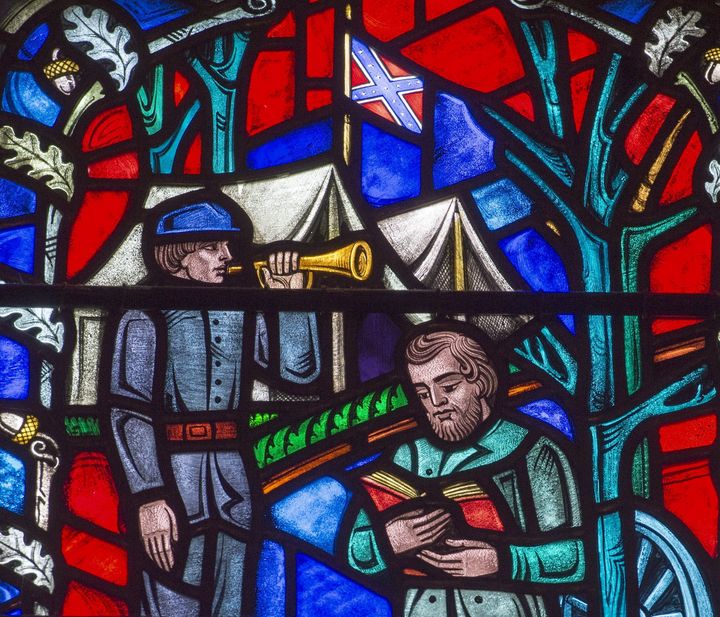The Washington National Cathedral, a central landmark in the U.S. capital, has announced its decision to remove two stained glass windows honoring Confederate Gens. Robert E. Lee and Stonewall Jackson.
The two 4-by-6-foot windows “are not only inconsistent with our current mission to serve as a house of prayer for all people, but also a barrier to our important work on racial justice and racial reconciliation,” church leaders wrote in a statement published Wednesday on the cathedral’s website. “Their association with racial oppression, human subjugation and white supremacy does not belong in the sacred fabric of this Cathedral.”
The statement, signed by Rev. Mariann Edgar Budde, bishop of the Episcopal Diocese of Washington, Rev. Randolph Marshall Hollerith, the cathedral’s dean, and John Donoghue, chair of the board of directors, said the decision came after two years of discussion and deliberation. The cathedral’s board voted it into effect on Tuesday.

“There are a lot of people who have felt alienated from the cathedral because of these windows,” Kevin Eckstrom, the cathedral’s chief communications officer, told HuffPost on Wednesday. “We don’t want anybody to have to check their identity or their history or their beliefs at the door when they come here.”
As a central hub for the U.S.-based Episcopal Church, the cathedral has hosted many prominent events over the years, including presidential funerals and inaugural events, most recently for President Donald Trump.
The Confederate-themed windows date back to 1953, when they were installed as a gift from the United Daughters of the Confederacy. They depict scenes from the two generals’ lives, as well as a representation of the Confederate battle flag.
The United Daughters of the Confederacy did not immediately respond to a request for comment on Wednesday.
“We’re not just talking about windows here. We’re talking about racial justice and the legacy of slavery and the role of the church in that.”
- Kevin Eckstrom, Washington National Cathedral
Former cathedral dean Gary Hall had previously called for the windows’ removal in 2015, after a white supremacist known to admire Confederate symbols and history killed nine black churchgoers in Charleston, South Carolina.
“In 2015, we know that celebrating the lives of these two men, and the flag under which they fought, promotes neither healing nor reconciliation, especially for our African-American sisters and brothers,” Hall told Religion News Service at the time.
In August, two days after violence erupted in Charlottesville, Virginia, as white supremacists rallied against the removal of a statue of Gen. Robert E. Lee, Hall reposted his earlier call on Facebook, commenting: “Just sayin’.”
Responding to a critic who suggested the windows’ removal would be akin to removing the face of slave-owning presidents from Mount Rushmore ― an argument Trump has also made ― Hall wrote:
“These monuments were designed and paid for by the United Daughters of the Confederacy in the 1950s to rebrand the confederacy and distract from the issue of slavery and civil rights. They are not innocent.”
Eckstrom also addressed the question of historical erasure, saying: “One of the common misunderstandings is that we’ll take the windows down and either throw them away or give them away. Actually we’re planning on preserving them and returning them to the cathedral in some way in a non-sacred place so they can have a second life as an educational tool.”
Cathedral leaders said they will deliberate further to determine what will replace the windows.

Surveys have found that Americans are generally unsupportive of attempts to remove memorials honoring Confederate leaders. One HuffPost/YouGov poll conducted in August found that one-third of Americans favor removing statues and memorials of Confederate leaders, with 49 percent opposed. Just 29 percent of Americans favor changing the names of streets, schools and buildings commemorating Confederate leaders, while half are opposed. Responses to similar surveys varied, based on how the question was asked and what different options were provided.
Several states, including North Carolina, Alabama and Mississippi, have laws on the books that make it particularly difficult to remove symbols of the Confederacy. In other places, local officials have worked swiftly to remove Confederate monuments without drawing attention from white supremacist and neo-Nazi groups.
With memories of the violence in Charlottesville still fresh, Eckstrom said the cathedral’s windows will be removed judiciously in a process that may take several days.
“Safety is a big concern for us, and it has been throughout this process,” he said. “We’re trying to do this in as dignified and safe a way as possible. We don’t really know what to expect, but have tried to plan for a number of scenarios.”
Removing the windows is a symbolic action that will hopefully underscore ongoing racial justice efforts, Eckstrom added, reiterating the cathedral’s official statement.
“We’re not just talking about windows here,” Eckstrom said. “We’re talking about racial justice and the legacy of slavery and the role of the church in that. After the windows are gone, we’re hoping to rally the attention around the harder work of racial reconciliation.”


